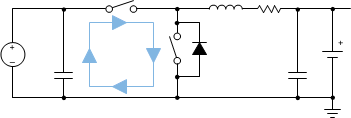ZHCSGR7 September 2017
PRODUCTION DATA.
- 1 特性
- 2 应用
- 3 说明
- 4 修订历史记录
- 5 说明 (续)
- 6 Pin Configuration and Functions
- 7 Specifications
-
8 Detailed Description
- 8.1 Overview
- 8.2 Functional Block Diagram
- 8.3
Feature Description
- 8.3.1 Power-On-Reset (POR)
- 8.3.2 Device Power Up from Battery without Input Source
- 8.3.3 Power Up from Input Source
- 8.3.4 Host Mode and Standalone Power Management
- 8.3.5 Power Path Management
- 8.3.6 Battery Charging Management
- 8.3.7 Shipping Mode
- 8.3.8 Status Outputs (PG, STAT)
- 8.3.9 Protections
- 8.3.10 Serial interface
- 8.4 Register Maps
- 9 Application and Implementation
- 10Power Supply Recommendations
- 11Layout
- 12器件和文档支持
- 13机械、封装和可订购信息
11 Layout
11.1 Layout Guidelines
The switching node rise and fall times should be minimized for minimum switching loss. Proper layout of the components to minimize high frequency current path loop (see Figure 29) is important to prevent electrical andmagnetic field radiation and high frequency resonant problems.
IMPORTANT
It is essential to follow this specific layout PCB order.
- Place input capacitor as close as possible to PMID pin and GND pin connections and use shortest copper trace connection or GND plane.
- Put output capacitor near to the inductor and the device.
- Decoupling capacitors should be placed next to the device pins and make trace connection as short as possible.
- Place inductor input terminal to SW pin as close as possible. Minimize the copper area of this trace to lower electrical and magnetic field radiation but make the trace wide enough to carry the charging current. Do not use multiple layers in parallel for this connection. Minimize parasitic capacitance from this area to any other trace or plane.
- It is OK to connect all grounds together to reduce PCB size and improve thermal dissipation.
- Try to avoid ground planes in parallel with high frequency traces in other layers.
See the EVM design for the recommended component placement with trace and via locations.
11.2 Layout Example
 Figure 29. High Frequency Current Path
Figure 29. High Frequency Current Path